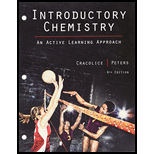
Concept explainers
(a)
Interpretation:
The density of air at STP having “effective” molar mass of
Concept Introduction:
The
The ideal gas equation resultant of all the ideal gas law’s is shown below.
Effective molar mass means the average molar mass of all the gases present in the air.
Answer to Problem 17E
The density of air at STP having “effective” molar mass of
Explanation of Solution
The ideal gas equation is shown below.
Where,
•
•
•
•
•
Density of any substance is defined as the mass per unit volume. That is, mass of the substance divided by the volume that mass is occupying.
Conversion of ideal gas equation in terms of density of gas is shown below.
Divide the equation (1) by
The number of moles of gas is related to its molar mass by the formula shown below.
Where,
•
•
Substitute the value of
Using equation (2) and simplify.
The formula of density of gas in terms of molar mass, temperature, and pressure is given below.
Under STP conditions temperature is
The molar mass of gas is provided as
Substitute the values of P, R, T and MM in the equation (3).
The density of gas at STP having molar mass of
The density of air at STP having “effective” molar mass of
(b)
Interpretation:
The density of air at temperature of
Concept Introduction:
The ideal
The ideal gas equation resultant of all the ideal gas law’s is shown below.
Effective molar mass means the average molar mass of all the gases present in the air.
Answer to Problem 17E
The density of air at temperature of
Explanation of Solution
The ideal gas equation is shown below.
Where,
•
•
•
•
•
Density of any substance is defined as the mass per unit volume. That is, mass of the substance divided by the volume that mass is occupying.
Conversion of ideal gas equation in terms of density of gas is shown below.
Divide the equation (1) by
The number of moles of gas is related to its molar mass by the formula shown below.
Where,
•
•
Substitute the value of
Using equation (2) and simplify.
The formula of density of gas in terms of molar mass, temperature, and pressure is given below.
Molar mass of oxygen gas is
The temperature of air is
The conversion of temperature in degree celsius to kelvin units is shown below.
Where,
•
•
Temperature of air in degree Celsius units is
Substitute the value
The conversion of pressure in torr to atm is shown below.
The pressure of
Substitute the values of P, R, T and MM in the equation (3).
The density of air at temperature of
The density of air at temperature of
Want to see more full solutions like this?
Chapter 14 Solutions
Bundle: Introductory Chemistry: An Active Learning Approach, 6th + OWLv2, 1 term (6 months) Printed Access Card
- Sulfur trioxide, SO3, is produced in enormous quantities each year for use in the synthesis of sulfuric acid. S(s)+O2(g)SO2(g)2SO2(g)+O2(g)2SO3(g) What volume of O2(g) at 350.C and a pressure of 5.25 atm is needed to completely convert 5.00 g sulfur to sulfur trioxide?arrow_forward50 The first step in processing zinc metal from its ore, ZnS, is to react it with O2 according to the reaction 2ZnS(s)+3O2(g)2ZnO(s)+2SO2(g) If 620 kg of ZnS is to be reacted, what volume of oxygen at 0.977 atm 34.0 C is needed (at a minimum) to carry out this reaction?arrow_forwardEthanol, C2H5OH, is produced industrially from ethylene, C2H4, by the following sequence of reactions: 3C2H4+2H2SO4C2H5HSO4+( C 2 H 5)2SO4C2H5HSO4+( C 2 H 5)2SO4+3H2O3C2H5OH+2H2SO4 What volume of ethylene at STP is required to produce 1.000 metric ton (1000 kg) of ethanol if the overall yield of ethanol is 90.1%?arrow_forward
 Chemistry: The Molecular ScienceChemistryISBN:9781285199047Author:John W. Moore, Conrad L. StanitskiPublisher:Cengage Learning
Chemistry: The Molecular ScienceChemistryISBN:9781285199047Author:John W. Moore, Conrad L. StanitskiPublisher:Cengage Learning Chemistry: An Atoms First ApproachChemistryISBN:9781305079243Author:Steven S. Zumdahl, Susan A. ZumdahlPublisher:Cengage Learning
Chemistry: An Atoms First ApproachChemistryISBN:9781305079243Author:Steven S. Zumdahl, Susan A. ZumdahlPublisher:Cengage Learning ChemistryChemistryISBN:9781305957404Author:Steven S. Zumdahl, Susan A. Zumdahl, Donald J. DeCostePublisher:Cengage Learning
ChemistryChemistryISBN:9781305957404Author:Steven S. Zumdahl, Susan A. Zumdahl, Donald J. DeCostePublisher:Cengage Learning
 Principles of Modern ChemistryChemistryISBN:9781305079113Author:David W. Oxtoby, H. Pat Gillis, Laurie J. ButlerPublisher:Cengage Learning
Principles of Modern ChemistryChemistryISBN:9781305079113Author:David W. Oxtoby, H. Pat Gillis, Laurie J. ButlerPublisher:Cengage Learning Chemistry for Engineering StudentsChemistryISBN:9781337398909Author:Lawrence S. Brown, Tom HolmePublisher:Cengage Learning
Chemistry for Engineering StudentsChemistryISBN:9781337398909Author:Lawrence S. Brown, Tom HolmePublisher:Cengage Learning





